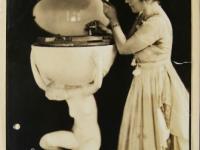Answer: A color-producing organ.
Mary Elizabeth Greenewalt (nee Hallock) was born in Beirut in 1871, and was educated in both Beirut and Philadelphia. In Philadelphia Greenewalt lived with the Quaker Heacock family and attended Chelten, their private school. As a pupil, Greenewalt displayed an aptitude for music as well as mathematics. After completing her studies at the Chelten School in 1888, Greenewalt studied piano at the Philadelphia Musical Academy, graduating in 1893. In 1897 Greenewalt traveled to Vienna to study with Theodor Leschetizky, who was noted for his teaching method emphasizing tone production. After returning from Vienna, Greenewalt married Dr. Frank L. Greenewalt, physician-in-chief at Philadelphia’s Girard College in 1898 in Johnstown, New York.
In the early 1900s Greenewalt developed an interest in exploring music’s emotional appeal. To that end, she turned to investigating colored lighting as a medium capable of giving expression to the combined mind-body response to music. Starting around 1905, she worked for over a decade to bring her research to life, which culminated in the color organ, or Sarabet, that she revealed in 1919. A few years prior, Greenewalt tested her ideas in a light-color demonstration before the Illuminating Engineering Society of Philadelphia at the city's renowned Bellevue-Stratford Hotel.
Greenewalt’s papers at HSP (#867) offer an impressive array of materials touching not only upon the creative processes of an artist-inventor but also on one women’s experience with the United States patent system in the early 20th century. Her collection includes legal papers related to her patents, correspondence, scrapbooks, brochures, clippings, and photographs.

